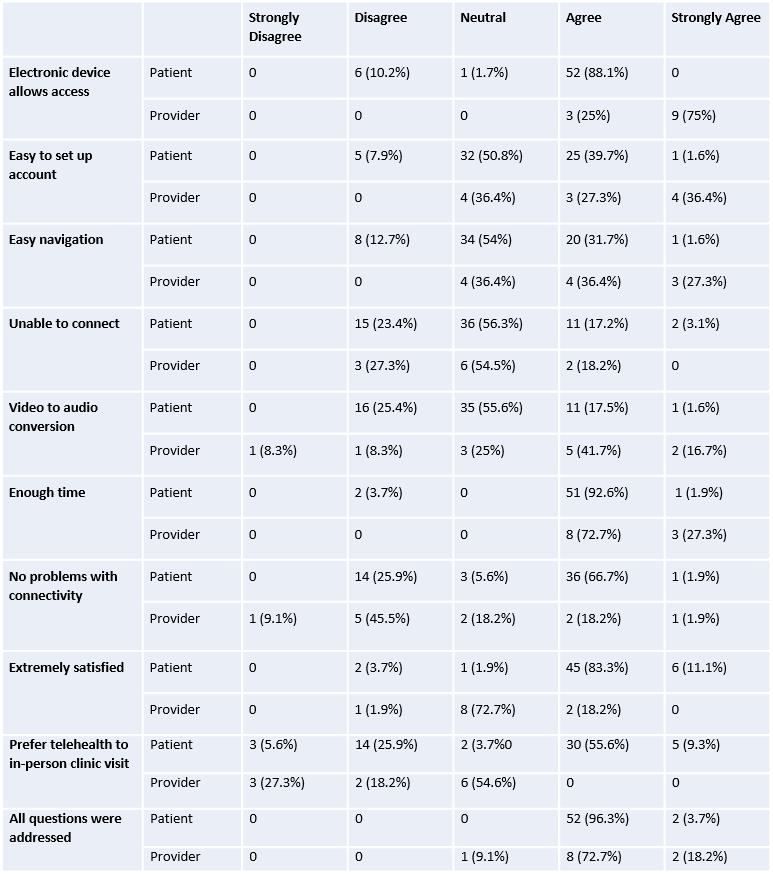Patient and Provider Perspectives on Telehealth Clinic Visits Precipitated by the Covid-19 Viral Pandemic
L. Adamski1, C. Alvarez1, M. Patterson2, C. Shen3, G. Kaur3, F. K. Butt3
1Penn State College of Medicine, Hershey, PA, 2University of South Carolina, Greenville, SC, 3Penn State Milton S Hershey Medical Center, Hershey, PA
Meeting: 2022 American Transplant Congress
Abstract number: 610
Keywords: COVID-19, Psychosocial, Resource utilization, Safety
Topic: Administrative » Administrative » 01 - Quality Assurance Process Improvement & Regulatory Issues
Session Information
Session Name: Quality Assurance Process Improvement & Regulatory Issues
Session Type: Poster Abstract
Date: Saturday, June 4, 2022
Session Time: 5:30pm-7:00pm
 Presentation Time: 5:30pm-7:00pm
Presentation Time: 5:30pm-7:00pm
Location: Hynes Halls C & D
*Purpose: The transplant community had to adjust to a new way of practicing medicine during the COVID-19 viral pandemic. Our transplant center quickly adapted to virtual clinic visits to maintain the safety of our immunosuppressed patients. The purpose of this study was to examine how patients and providers regarded this new method of delivering healthcare.
*Methods: Patients with a telehealth transplant clinic visit between March 2020 and April 2021 were recruited to participate in a telephone survey, which consisted of 19 statements rating their experience on a 5-point Likert Scale. Two additional questions allowed participants to offer suggestions for improvement. Demographic information was also collected. Multi-specialty healthcare providers and support staff in the transplant division who had conducted telehealth visits were contacted via email to participate in an electronic survey, consisting of 25 statements that asked providers to assess their telehealth experience on a 5-point Likert Scale. They were also able to provide additional comments regarding their experience.
*Results: Results are summarized in Table 1. The majority of patients and providers had an electronic device that allowed access to video telehealth visits and felt that the telehealth platform was easy to navigate. Statistical significance was found between not pursuing higher education and not having a video visit-capable device (p=0.035). Retired or disabled patients were more likely to find that setting up an account and navigating the video platform was difficult (p=0.022). Both patients and providers agreed that when they experienced connectivity issues with the video platform, it was easy to convert to a telephone call. Both groups reported having ample time during their telehealth visit and felt that all questions and concerns were adequately addressed. More patients than providers preferred the telehealth visit to an in-person clinic visit, as they mentioned the convenience of the telehealth visit when a lengthy commute was involved.
*Conclusions: The viral pandemic required both patients and providers to adapt to telehealth visits. Social determinants of health should be taken into consideration to provide sufficient care, as certain populations may require extra assistance to utilize this platform effectively. Overall, most providers and patients agreed that adequate care can be provided via telehealth, supporting the continued use of this platform in the future.
To cite this abstract in AMA style:
Adamski L, Alvarez C, Patterson M, Shen C, Kaur G, Butt FK. Patient and Provider Perspectives on Telehealth Clinic Visits Precipitated by the Covid-19 Viral Pandemic [abstract]. Am J Transplant. 2022; 22 (suppl 3). https://atcmeetingabstracts.com/abstract/patient-and-provider-perspectives-on-telehealth-clinic-visits-precipitated-by-the-covid-19-viral-pandemic/. Accessed December 23, 2025.« Back to 2022 American Transplant Congress

